Bloom Where You’re Planted: Essential Gardening Tips for Every Green Thumb
Article by: Suzette Morshead
Gardening is not just a hobby; it’s a nurturing act that connects us to nature and gives us a sense of accomplishment. The phrase "Bloom Where You’re Planted" signifies the importance of making the most of your circumstances, and this philosophy can be seamlessly applied to gardening. Whether you have a vast backyard, a small balcony, or even just a windowsill, you can cultivate beauty. Here’s how to embrace your green thumb with essential gardening tips, along with supplies that can set you on the right path.
Getting Started: Know Your Environment
Before digging into the soil, take a moment to assess your environment. Each garden is unique, shaped by its climate, soil type, and available sunlight. Here are some steps to consider:
-
Sunlight: Observe how much sunlight your space gets throughout the day. Most plants thrive in full sun (around 6-8 hours of direct sunlight), but some prefer partial shade or full shade.
-
Soil Quality: Assess the quality of your soil. Healthy soil should be rich in organic matter and well-drained. A soil test kit can help determine pH levels and nutrient content.
- Climate Conditions: Research your hardiness zone to identify which plants are best suited for your region. This will inform your choices and increase the likelihood of success.
Choosing the Right Plants
Once you understand your growing conditions, it’s time to select plants that align with your environment. Consider your goals: are you growing flowers, vegetables, or perhaps a combination of both? Here are some great options:
-
For Beginners: Sunflowers, marigolds, and zinnias are stunning and easy to grow for floral gardens. If you’re leaning toward edible gardening, lettuce, radishes, and herbs like basil and mint are forgiving choices.
-
Container Gardening: For those with limited space, opt for container gardening. Vegetables like tomatoes, peppers, and even dwarf fruit trees thrive in pots.
- Native Plants: Incorporate local flora that attract pollinators and support wildlife. Native plants are generally more resilient and require less maintenance.
Personal Story: A Journey to Blooming
Not long ago, I found myself in a new city, living in a small apartment with a tiny balcony. Surrounded by concrete and noise, I felt disconnected from nature. Remembering the phrase "Bloom Where You’re Planted," I decided to transform my small space into a mini-oasis.
With just a few pots and some seedlings, I began my journey. I chose herbs like rosemary and thyme, along with vibrant petunias. Each morning, I watered them lovingly and watched as they grew. Within weeks, those small plants became a tapestry of greenery—each bud a reminder that beauty can flourish even in less-than-ideal conditions. Not only did my mental well-being improve, but I found new joy in cooking with fresh herbs I had grown.
This experience taught me that with a little effort and creativity, even the smallest spaces could become a source of growth and inspiration.
Essential Gardening Supplies
To make your gardening experience successful, you’ll need some basic supplies. Here’s a list that can set you up for success:
Tools and Equipment
-
Hand Tools: A trowel, hand rake, and pruners are must-haves for planting, tending, and harvesting plants.
-
Watering Can: Choose one with a narrow spout for precision watering.
-
Garden Hose or Drip Irrigation System: If you have a larger space, consider a hose or an irrigation system for efficient watering.
- Gloves: Protect your hands from thorns and dirt with a sturdy pair of gardening gloves.
Soil and Fertilizers
-
Potting Soil: High-quality potting mix is essential for container gardening, providing nutrients and drainage.
-
Compost: Compost enriches the soil, improves drainage, and boosts plant health.
- Fertilizer: Organic fertilizers are a great way to ensure your plants receive necessary nutrients without harmful chemicals.
Gardening Accessories
-
Pots and Containers: Select various sizes to accommodate your plants’ growth.
-
Plant Markers: Keep track of what you’ve planted for easy identification.
- Mulch: Helps retain soil moisture and suppresses weeds.
Optional Extras
-
Garden Journal: Keep records of what you plant, when you plant it, and any challenges you face. This helps track your progress and learn from each season.
-
Seed Catalogs: Exploring various seed options can inspire your gardening plans and provide insights into planting timelines.
- Insect Identification Guide: Helps you recognize beneficial insects and remove pests effectively.
Maintenance and Care
Understanding that gardening is a continuous journey is crucial. Regular maintenance includes:
-
Watering: Keep a consistent watering schedule, adjusting based on rainfall and plant needs.
-
Weeding: Regularly remove unwanted plants that compete for nutrients and water.
-
Fertilizing: Follow the recommended schedule for fertilization to promote healthy plant growth.
- Pruning: Trim dead or damaged leaves to keep your plants healthy and encourage new growth.
Conclusion: Your Garden Is a Reflection of You
Gardening embodies patience, creativity, and resilience, qualities that echo the sentiment of "Bloom Where You’re Planted." No matter the scale of your gardening endeavor, the importance lies in nurturing your space and allowing it to flourish.
Remember my small balcony, now a thriving garden? It’s a place of solace, joy, and growth. As you embark on your gardening journey, may your plants not only bloom, but may you also find your own roots taking hold in the process. So, gather your supplies, dig your hands into the earth, and let your garden tell your unique story. Happy gardening!
Bloom Where You’re Planted: Essential Gardening Tips for Every Green Thumb
Article by: Suzette Morshead


